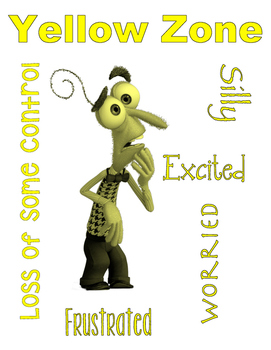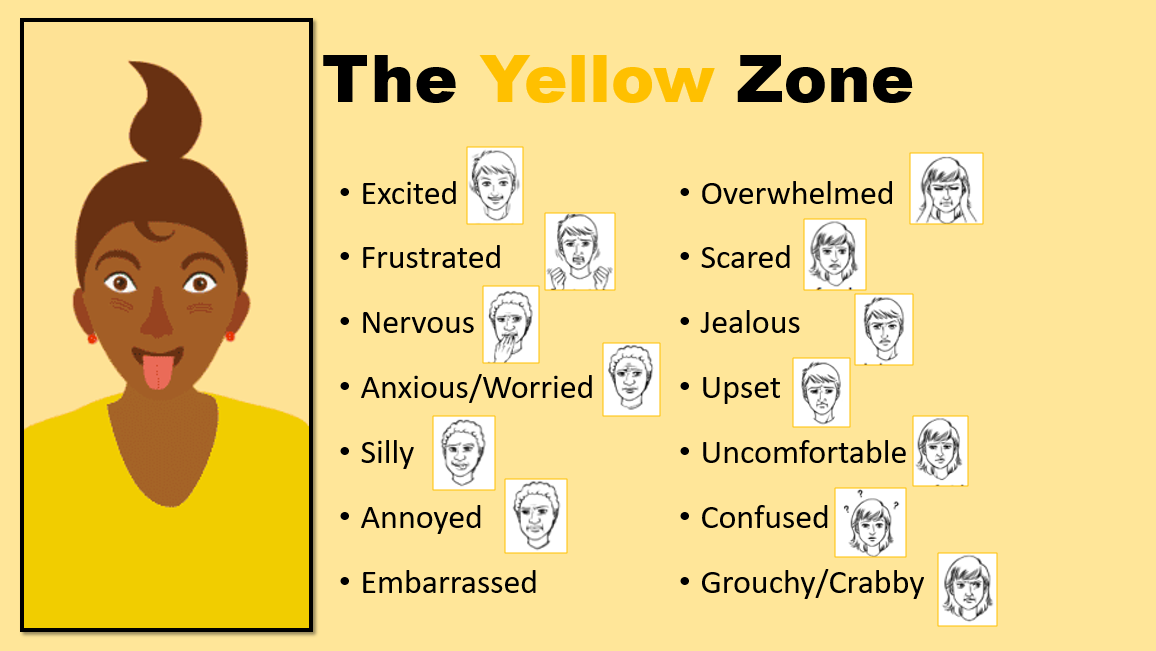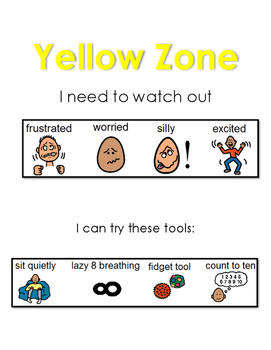Yellow Zone Of Regulation : What it is
Example of Deep Breathing Exercise:

Take a moment to pause and find a comfortable position. Close your eyes and take a deep breath in through your nose, filling your lungs with air. Hold your breath for a few seconds, allowing your body to experience that fullness. Then, exhale slowly through your mouth, releasing any tension or stress you may be carrying. Repeat this cycle several times, allowing each breath to calm and center you.
3. Mindfulness and Grounding Techniques: Mindfulness exercises can be extremely helpful in managing emotions in the Yellow Zone. Engage in activities that allow you to focus on the present moment, such as mindfulness meditation, breathing exercises, or grounding techniques. Grounding techniques involve redirecting your attention to the physical sensations in your body or your immediate surroundings. This can help shift your focus away from anxious or worrisome thoughts.Example of Grounding Technique: Five Senses

Grounding techniques can help bring you back to the present moment, allowing you to focus on what is happening around you. The Five Senses technique is a simple yet effective grounding exercise. Begin by taking a few deep breaths and then:
- Sight: Identify five things you can see around you. Take note of their colors, shapes, and textures.
- Hearing: Identify four things you can hear. It could be the sound of birds chirping, people talking, or the hum of a fan.
- Touch: Identify three things you can touch. It could be the sensation of a soft blanket, the texture of your clothes, or the feeling of the ground beneath your feet.
- Smell: Identify two things you can smell. It could be the scent of flowers, freshly baked cookies, or the aroma of coffee.
- Taste: Identify one thing you can taste. It could be a sip of water, a mint, or a piece of fruit.
Positive Self-Talk: I Can Face Challenges

In times of frustration or anxiety, it is essential to remind yourself that you are capable and strong. Repeat the following positive affirmations to yourself:
"I am resilient and can handle challenges."
"I have overcome similar situations in the past, and I can do it again."
"I am in control of my emotions, and I choose to stay calm and composed."
The above strategies are just a few examples of how you can navigate the Yellow Zone effectively. Remember that each individual is unique, and what works for one person may not work for another. It is important to find strategies and techniques that resonate with you and incorporate them into your daily routine. FAQs about the Yellow Zone: Q1: How do I know if I'm in the Yellow Zone? A1: The Yellow Zone is characterized by a moderate level of emotional arousal. Some signs that you may be in the Yellow Zone include feeling slightly anxious, restless, or excited. You may also notice changes in your breathing, heart rate, or body temperature. Q2: Is it normal to experience the Yellow Zone? A2: Yes, it is entirely normal to experience emotions within the Yellow Zone. Everyone experiences a range of emotions throughout the day, and it is essential to recognize that these emotions are a natural part of life. Q3: How long does someone typically stay in the Yellow Zone? A3: The duration of time spent in the Yellow Zone varies from person to person and from situation to situation. Some individuals may quickly regulate their emotions and move out of the Yellow Zone, while others may require more time and support. Q4: Are there any activities that can help me regulate my emotions in the Yellow Zone? A4: Engaging in activities that bring you joy, such as listening to music, drawing, journaling, or going for a walk, can help regulate your emotions in the Yellow Zone. Experiment with different activities to find what works best for you. Q5: Can children benefit from learning about the Yellow Zone? A5: Absolutely! Teaching children about emotions and providing them with strategies to manage the Yellow Zone is invaluable. It helps them develop emotional intelligence, self-regulation skills, and cope with everyday challenges more effectively. In conclusion, understanding and managing our emotions is a lifelong journey. The Yellow Zone of Regulation serves as a powerful tool to increase self-awareness and promote emotional well-being. By recognizing our emotions within the Yellow Zone and implementing effective strategies, we can better navigate challenging situations and lead more balanced lives. Remember, self-regulation is a skill that can be developed and improved over time with practice and patience.Yellow Zone Of Regulation Inside Out By Creatively Themed | TpT
 Image Source : www.teacherspayteachers.com
Image Source : www.teacherspayteachers.com regulation zone yellow inside zones emotions activities feelings school fear choose board teaching
Printable Zones Of Regulation
 Image Source : 7printable.click
Image Source : 7printable.click Yellow Zone, Zones Of Regulation-Counsel&Create | Counseling, School
 Image Source : www.pinterest.com
Image Source : www.pinterest.com regulation zones
TechTeachTiger: October 2013
 Image Source : megkingabraham.blogspot.com
Image Source : megkingabraham.blogspot.com zone yellow emotions show
Me In My Zones - Yellow Zone By Positively Behavior | TpT
 Image Source : www.teacherspayteachers.com
Image Source : www.teacherspayteachers.com zones zone yellow subject
Zones Of Regulation: Yellow Zone By Ms Code's Teaching Treasures
 Image Source : www.teacherspayteachers.com
Image Source : www.teacherspayteachers.com zones regulation zone yellow teaching strategies teacherspayteachers emotions activities resources behavior posters skills try when
Red Yellow Zone | Zones Of Regulation, Emotional Regulation, Social
 Image Source : www.pinterest.ca
Image Source : www.pinterest.ca coping emotional ddsb
Zones Of Regulation - Yellow Zone - Need To Take Caution - Try These
 Image Source : www.pinterest.com
Image Source : www.pinterest.com zone regulation zones tools yellow coping skills emotional self emotions caution green poster take try need visit face behavior teacherspayteachers
Yellow zone, zones of regulation-counsel&create. Regulation zone yellow inside zones emotions activities feelings school fear choose board teaching. Techteachtiger: october 2013. Red yellow zone. Me in my zones